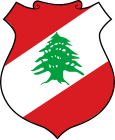Elections in Lebanon: Difference between revisions
m not a stub; see stubsensor |
|||
| Line 54: | Line 54: | ||
*[http://www.libanvote.com/lebanese9296/ Libanvote]: an exhaustive record of all elections since [[1927]], with a constituency-by-constituency breakdown of votes by candidate, together with any subsequent byelections for particular constituencies. |
*[http://www.libanvote.com/lebanese9296/ Libanvote]: an exhaustive record of all elections since [[1927]], with a constituency-by-constituency breakdown of votes by candidate, together with any subsequent byelections for particular constituencies. |
||
*[http://www.electionworld.org/lebanon.htm Electionworld] |
*[http://www.electionworld.org/lebanon.htm Electionworld] |
||
*[http://electionsinfo.com/election-information/viewtopic.php?t=64 ElectionsInfo.com on Lebanon Elections] |
|||
[[Category:Elections in Lebanon]] |
[[Category:Elections in Lebanon]] |
||
Revision as of 11:30, 6 May 2005
 |
|---|
|
|
Elections in Lebanon gives information on election and election results in Lebanon.
Lebanon's national legislature is called the Assembly of Representatives (Majlis al-Nuwab in Arabic). Since the elections of 1992 (the first since the reforms of the Taif Agreement of 1989 removed the built-in majority previously enjoyed by Christians and distributed the seats equally between Christians and Muslims), the National Assembly has had 128 seats. The term was four years, but has recently been extended to five.
Seats in the National Assembly are confessionally distributed but elected by universal suffrage. Each religious community has an allotted number of seats in the National Assembly (see the table below). They do not represent only their co-religionists, however; all candidates in a particular constituency, regardless of religious affiliation, must receive a plurality of the total vote, which includes followers of all confessions. The system was designed to minimize inter-sectarian competition and maximize cross-confessional cooperation: candidates are opposed only by co-religionists, but must seek support from outside of their own faith in order to be elected.
In practice, this system has led to charges of gerrymandering. The opposition Qornet Shehwan Gathering, a group opposed to the present pro-Syrian regime, has claimed that constituency boundaries have been drawn so as to allow many Shi'a Muslims to be elected from Shi'a-majority constituencies (where the Hizbullah Party is strong), while allocating many Christian members to Muslim-majority constituencies, forcing Christian politicians to represent Muslim interests. (Similar charges, but in reverse, were made against the Chamoun administration in the 1950s).
BEFORE TAIF AFTER TAIF
========================================================================================
Religion
Denomination
----------------------------------------------------------------------------------------
Christian 54 64
Maronite 30 34
Greek Orthodox 11 14
Greek Catholic 6 8
Armenian Orthodox 4 5
Armenian Catholic 1 1
Protestant 1 1
Other Christians 1 1
Muslim 45 64
Sunni 20 27
Shi'a 19 27
Druze 6 8
Alawite 0 2
----------------------------------------------------------------------------------------
Total 99 128
----------------------------------------------------------------------------------------
The President is elected for a six year term by the parliament.
Lebanon has numerous political parties, but they play a much less significant role in Lebanese politics than they do in most parliamentary democracies. Many of the "parties" are simply lists of candidates endorsed by a prominent national or local figure. Loose coalitions, usually organized locally, are formed for electoral purposes by negotiation among clan leaders and candidates representing various religious communities; such coalitions usually exist only for the election, and rarely form a cohesive bloc in the National Assembly after the election. No single party has ever won more than 12.5 percent of the seats in the National Assembly, and no coalition of parties has won more than 35 percent.
Especially outside of the major cities, elections tend to focus more on local than national issues, and it is not unusual for a party to join an electoral ticket in one constituency while aligned with a rival party - even an ideologically opposite party - in another constituency.
Presidential elections are indirect, with the President being elected to a six-year term by the National Assembly.
Last elections
This section needs expansion. You can help by adding to it. |
Past elections
This section needs expansion. You can help by adding to it. |
See also
External links
- Adam Carr's Election Archive
- Libanvote: an exhaustive record of all elections since 1927, with a constituency-by-constituency breakdown of votes by candidate, together with any subsequent byelections for particular constituencies.
- Electionworld
- ElectionsInfo.com on Lebanon Elections
